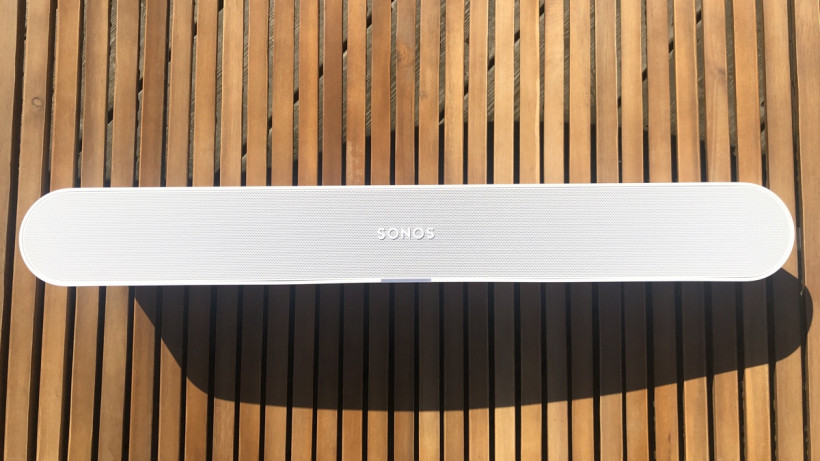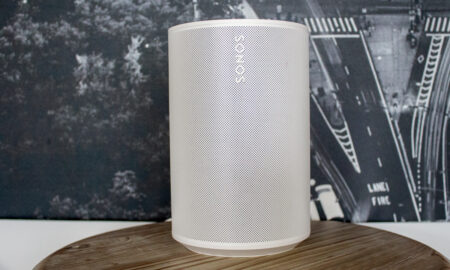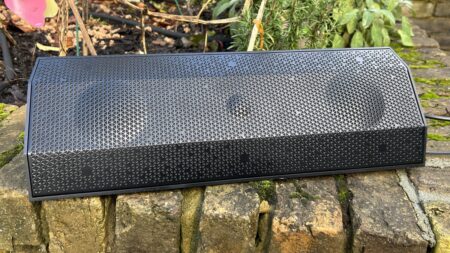Sonos' entry level smart soundbar put to the test
If you’re already a Sonos believer, none of the Ray’s shortcomings should put you off - and anyway, they’re pretty mild. But if you’re simply after a reasonably affordable, reasonably compact soundbar to put a rocket up your TV’s sound, the Ray is far from the only game in town. Yamaha, in particular, can sell you a better-sounding alternative for slightly less money.
Pros
- Neat, tidy, and nicely finished
- Direct, detailed sound
- Wider system integration
- Easy setup
Cons
- Not a particularly big sound
- Treble is reticent
- HDMI option would be nice
- No Dolby Atmos
The Sonos Ray was announced in early 2022 and is the multi-room audio giant’s most affordable soundbar thus far.
In just a couple of well-considered moves, Sonos has transformed its rather desultory range of soundbars and soundbases (remember when they were a thing?) into arguably the most successful products in its entire line-up.
Certainly the Sonos Arc and the Beam v2 are there-or-thereabouts whenever talk turns to the best-performing, best-value soundbars at their respective price-points.
And now, to complete a three-strong soundbar line-up, is the Sonos Ray. It’s priced to slot in below the 2nd-gen Beam, and it’s specified to reflect its position as the most affordable Sonos soundbar you can buy.
The Ray costs ‘just’ $279 / £279.
I put the ‘just’ in quotes there as it’s hardly a budget soundbar to rival the likes of the $130 Roku Streambar, but it is Sonos’ most affordable TV speaker to date.
- Rivals: The best smart soundbars
- Sonos soundbar showdown: Sonos Beam 2 vs Sonos Arc
This is a soundbar of the old school – but although its membership of the Planet’s Leading Multi-Room Ecosystem will make it a no-brainer for some customers, the rest of us realise the Ray is far from short of competition.
So the question is: does it compete?
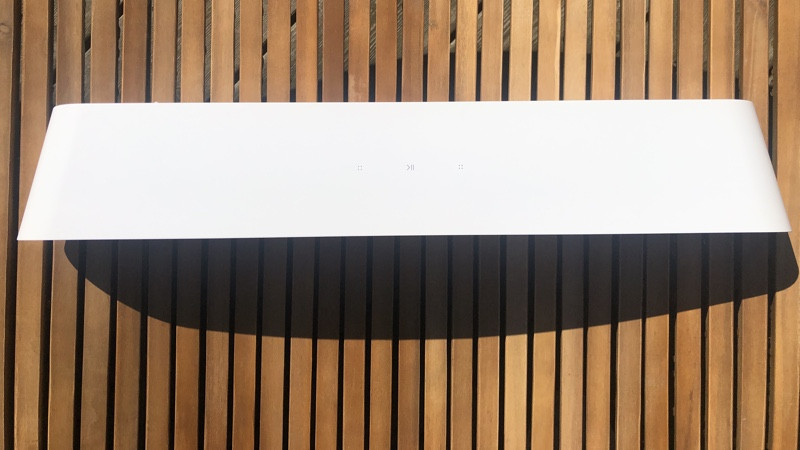
Sonos Ray: Design and hardware
In the same way that even small cars are quite big these days, soundbar inflation means that those who own smaller TVs (and by ‘smaller’, we mean ‘sub-48-inch’) aren’t exactly spoiled for choice.
The Ray, though, is a mere 71 x 559 x 95mm – and this means it won’t look overgrown sitting beneath a 40-inch TV screen.
And it looks pretty good once it’s there, too. The Ray is available in the long-established Sonos finishes of matte black or matte white, and its rounded-off ends and non-parallel sides make it look quite sophisticated in an understated sort of way.
Or anonymous, if you’re not into the whole ‘minimalism’ thing. Build quality is standard Sonos, too – which means it’s expertly constructed and properly finished.
The Ray is a stereo speaker – none of your fancy-pants multiple-drivers-firing-in-all-directions Dolby Atmos compatibility here.
More: Sonos tips and tricks
The audio business is done by two tweeters and two mid/bass drivers (‘midwoofers’ is the borderline-meaningless descriptions Sonos insists on), supported by a pair of bass reflex ports.
Everything faces dead-ahead, which makes the Ray helpfully relaxed about positioning – it’ll even sit happily on a middle shelf with surfaces both above and alongside it. Sonos will even sell you a wall-bracket if that’s more use.
It’s worth bearing in mind that at over 7cm, the Ray is a relatively tall soundbar – so if it’s going on the same shelf as your TV, make sure it doesn’t impact on the bottom of the screen.
Because this is Sonos we’re dealing with, details of the size and composition of the drivers themselves are extremely thin on the ground.
Similarly, we’ve no idea how much power is delivered by the four blocks of Class D amplification on board the Ray. This sort of inexplicable secrecy is standard Sonos practice, but it never fails to baffle.
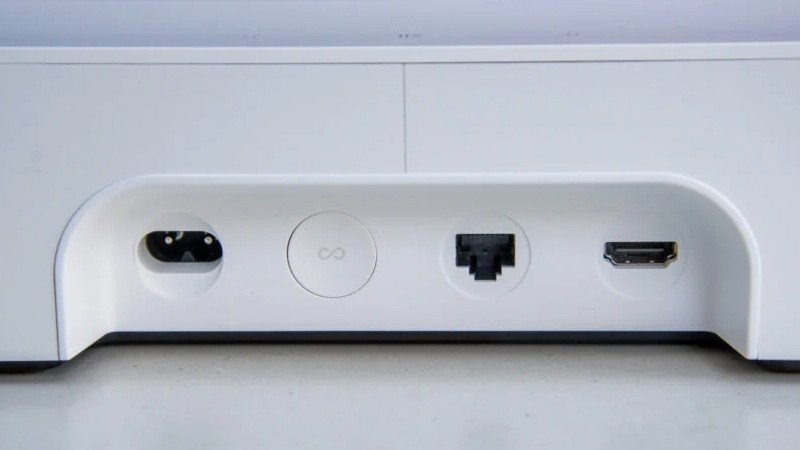
Physical connectivity extends to an Ethernet socket, a digital optical input and a figure-of-eight mains socket.
Unlike the Beam 2 and the Arc, which offers glorious Dolby Atmos through HDMI (provided your TV has an eARC port), there’s just optical audio on the Ray, there’s no HDMI in sight.
That means it’s ‘limited’ to just Stereo PCM, Dolby Digital and DTS Digital Surround.
You will be able to use the Ray as the center channel of a surround system – paired with a couple of rear Sonos Ones, for example… although I’d question the sanity of anyone adding a $749 Sub to a $249 soundbar.
The was interesting speculation that the Sonos Ray would be able to be used as part of a 5.1 TV surround sound system, at the rear – but that’s not the case (at least, not yet).
You can argue a case for HDMI being unnecessary for a product that doesn’t deal with any particularly complicated digital audio information, but if for no other reason than convenience it would be nice to have the option.

Sonos Ray: Set-up and wireless options
The simplicity of the Ray’s configuration means it’s one of the easiest products to set up you’re ever likely to encounter.
Once you’ve decided where you want to position it, attach the Ray to the mains and to your TV using the digital optical cable provided.
Open the Sonos S2 control app (which continues to be an absolute paradigm of clarity, simplicity, stability and common sense) and follow the very few instructions, and you’re good to go.
iOS users can deploy the Sonos ‘Trueplay’ room calibration feature on their smartphone, too. Just pace around your listening space brandishing your iPhone and the Ray will (quickly, accurately) set itself up to your specific environment. The app allows adjustment of bass and treble, of course, but ‘Trueplay’ is as effective here as it’s ever been.
You get both AirPlay 2 and Spotify Connect compatibility and the usual array of Sonos soundbar features such as IR remote skills, Trueplay, Night Sound and Speech Clarity.
Of course, this being a Sonos speaker, it is also capable of grouping with its stablemates for music playback in a Sonos multi-room setup.

Sonos Ray: Voice-control and multi-room
The Ray itself is not a smart speaker – but if you use a Sonos One SL, say, as one of the rear speakers in a surround-sound set-up, voice-control with digital assistants like Google Assistant or Alexa are available.
And Sonos has its own bespoke voice-assistant coming ‘soon’. Otherwise, control is via the admirable app or the ‘play/pause’ and ‘volume up/down’ capacitive controls on the soundbar’s top surface.
The app is also great for easing the Ray into a true surround-sound system (even incorporating a Sonos subwoofer if you so desire), or a wider multi-room set-up.
The ease, stability and effectiveness of this operation (and its results) is a big part of why Sonos is rapidly approaching ubiquity.
Sonos Ray: Sound quality
First things first: you need to manage your expectations. This is a stereo speaker, and stereo sound is what it does.
So if you’re expecting the sort of sonic fireworks the Beam v2 is capable of, it’s very possible you’ll feel short-changed. If, however, you’re after nothing more than a big improvement on the (inevitably thin and wheezy) sound your TV currently produces by itself, the Ray is entirely fit for purpose.
The tonal balance is pretty good. Movies tend to keep the bulk of their information in the midrange, of course, and here the Ray is poised, characterful and carries plenty of detail – and it projects the midrange well, positioning dialogue towards the front of the stage even if the action is kicking off all around. It’s clear and distinct where voices are concerned, and as a consequence movies are always easy to follow.
At the bottom end, there’s considerably more heft and wallop than your TV has a prayer of generating by itself.
Again, detail levels are respectably high, and again there’s plenty of control. Bass sounds always stay in their lane, so even when the going gets rowdy the Ray controls the low-frequency stuff well enough to prevent the midrange getting swamped.
Tonal variation is decent, too – some ‘affordable’ tend to thump along on one note, but the Ray delivers a fair bit of light and shade in its low-end activity.
Up at the top of the frequency range, though, the Ray is quite a bit more circumspect. There are the same admirable detail levels as elsewhere, and treble information never threatens to get out of hand – but that’s a negative as well as a positive.
The top end is rolled off here, slightly but obviously, and as a result the treble reproduction doesn’t have quite the bite or brilliance it needs.
Dynamically, the Ray is pretty good – it’s certainly able to switch from ‘near silence’ to ‘massive Hollywood blockbuster set-piece’ without sounding stressed about it.
Low-level dynamics are apparent too, and given believably context in the overall presentation. But there’s no denying the Ray is a fairly small-scale listen – it creates a believable soundstage and organises it pretty well, but it’s not very big. ‘Far-left’ and ‘far-right’ are quite close together, and there’s always an obvious point-source of sound.
All of these traits, both good and not-so-good, assume you’re listening at realistic volume. Turn the Ray up towards its maximum and its tonal balance shifts, with low frequencies attempting to dominate. The knock-on effect is that treble sounds become even more inhibited, and the overall balance takes a turn for the shouty.


